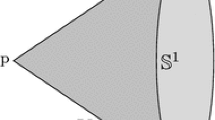Abstract
A topological dynamical system (X, f) is said to be multi-transitive if for every n ∈ ℕ the system (X n, f × f 2 × … × f n) is transitive. We introduce the concept of multi-transitivity with respect to a vector and show that multi-transitivity can be characterized by the hitting time sets of open sets, answering a question proposed by Kwietniak and Oprocha (2012). We also show that multi-transitive systems are Li-Yorke chaotic.
Similar content being viewed by others
References
Akin E. Recurrence in Topological Dynamical Systems: Families and Ellis Actions. The University Series in Mathematics. New York: Plenum Press, 1997
Akin E, Kolyada S. Li-Yorke sensitivity. Nonlinearity, 2003, 16: 1421–1433
Blanchard F, Host B, Maass A. Topological complexity. Ergod Theor Dyn Syst, 2000, 20: 641–662
Furstenberg H. Disjointness in ergodic theory, minimal sets, and a problem in diophantine approximation. Math Syst Theory, 1967, 1: 1–49
Furstenberg H. Recurrence in Ergodic Theory and Combinatorial Number Theory. Princeton, NJ: Princeton University Press, 1981
Glasner E. Classifying dynamical systems by their recurrence properties. Topol Methods Nonlinear Anal, 2004, 24: 21–40
Gottschalk W H, Hedlund G A. Topological Dynamics. Providence, RI: Amer Math Soc, 1955
Huang W, Ye X D. Devaney’s chaos or 2-scattering implies Li-Yorke’s chaos. Topology Appl, 2002, 117: 259–272
Huang W, Ye X D. Topological complexity, return times and weak disjointness. Ergod Theor Dyn Syst, 2004, 24: 825–846
Huang W, Ye X D. Dynamical systems disjoint from any minimal system. Trans Amer Math Soc, 2005, 357: 669–694
Kwietniak D, Oprocha P. On weak mixing, minimality and weak disjointness of all iterates. Ergod Theor Dyn Syst, 2012, 32: 1661–1672
Li J. Transitive points via Furstenberg family. Topology Appl, 2011, 158: 2221–2231
Li T Y, Yorke J. Periodic three implies chaos. Amer Math Monthly, 1975, 82: 985–992
Moothathu T S. Diagonal points having dense orbit. Colloq Math, 2010, 120: 127–138
Mycielski J. Independent sets in topological algebras. Fund Math, 1964, 55: 139–147
Opracha P. Weak mixing and product recurrence. Ann Inst Fourier (Grenoble), 2010, 60: 1233–1257
Author information
Authors and Affiliations
Corresponding author
Rights and permissions
About this article
Cite this article
Chen, Z., Li, J. & Lü, J. On multi-transitivity with respect to a vector. Sci. China Math. 57, 1639–1648 (2014). https://doi.org/10.1007/s11425-014-4797-z
Received:
Accepted:
Published:
Issue Date:
DOI: https://doi.org/10.1007/s11425-014-4797-z




